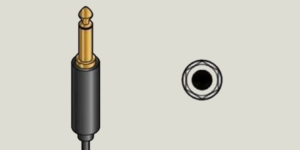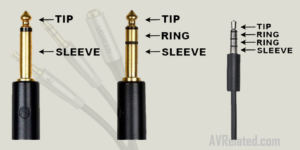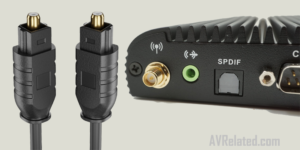Understanding audio connectors and interfaces is crucial for AV professionals, musicians, engineers, and enthusiasts, ensuring optimal performance, minimal signal degradation, and system compatibility. This guide explores the historical evolution, technical specifications, and practical applications of these connectors, tracing their development from early analog designs to sophisticated digital and wireless solutions. The evolution reflects the growing demands for higher fidelity, increased functionality, and greater convenience in audio production and reproduction.
Balanced vs. Unbalanced Connections
Balanced and unbalanced audio are ways to send sound signals. Unbalanced audio uses one wire for the sound and another for the ground. It’s simple and cheap but can pick up noise over long distances, so it’s often used in home audio systems. Balanced audio uses two wires that carry the same sound but in opposite ways, plus a ground wire. This setup cancels out noise and keeps the signal clear over long distances, making it better for professional audio equipment.
Balanced connections use three conductors (positive, negative, and ground) to transmit signals, which significantly reduces noise and interference. Unbalanced connections use two conductors (signal and ground) and are more susceptible to noise.
Historical Evolution of Audio Connectors
¼-Inch TS (Tip-Sleeve):

This mono connector has two conductors – tip for signal and sleeve for ground. It is typically used for unbalanced signals, such as those from electric guitars and some mono microphones.
The typical diameter is 6.35mm. TS connectors can handle signals up to 48V.
TRS (Tip-Ring-Sleeve):

An extension of the TS connector, the TRS includes an additional ring conductor. It supports balanced signals or stereo unbalanced signals.
Similar in size to TS, but with three conductors. Used in professional audio for balanced connections and stereo headphones.
XLR Connectors:

Developed by Cannon in the 1950s, XLR connectors are essential in professional audio for their robustness and reliability in delivering balanced audio signals. XLR connectors typically carry balanced audio signals, which are less susceptible to noise and interference. Standard 3-pin configuration – pin 1 (ground), pin 2 (hot), and pin 3 (cold). There are also 4, 5, and 7-pin versions for specific applications.
Phono/RCA Connectors:

RCA connectors, also known as phono connectors, Developed by the Radio Corporation of America in the 1940s , became widespread in the mid-20th century, particularly in consumer electronics.Common in home audio and video equipment for unbalanced audio signals.
Typically carry analog signals but can also handle digital signals in certain contexts (e.g., S/PDIF).
3.5mm and 2.5mm TRS Connectors:

Widely used in consumer electronics like smartphones, laptops, and portable audio players.The 3.5mm connector is standard for headphones and microphones, while the smaller 2.5mm variant is used in some specialized devices.
Banana Plugs and Speaker Terminals:

Common in high-fidelity home audio systems and professional speaker setups. Designed for easy insertion and secure connections. They can handle high power levels required by speakers.
AES/EBU:
A professional digital audio interface standardized by AES (Audio Engineering Society) and EBU (European Broadcasting Union)
Uses XLR connectors for balanced connections and can handle up to 24-bit/192 kHz audio. Common in studio and broadcast environments for high-quality audio transmission.
S/PDIF (Sony/Philips Digital Interface Format):

Used for transmitting digital audio signals in consumer electronics.
Coaxial and Optical Variants: Coaxial uses RCA connectors, while optical uses TOSLINK connectors. Supports up to 24-bit audio at 96 kHz.
ADAT Lightpipe:
An optical fiber interface used primarily in professional audio for multi-channel audio transmission.
Multi-Channel Audio Transmission: Supports up to 8 channels of 24-bit audio at 48 kHz, Commonly used in recording studios for connecting audio interfaces and digital mixers.
Audio Interfaces
USB Audio Interfaces:
USB audio interfaces have evolved from USB 1.1 to USB 3.0 and beyond, offering increased bandwidth and lower latency. Support for multiple channels, high-resolution audio, and various sample rates.
FireWire Audio Interfaces:
Once popular for their high data transfer rates and low latency, particularly in professional audio, Supports up to 400 Mbps (FireWire 400) and 800 Mbps (FireWire 800), Declined in popularity with the advent of USB 3.0 and Thunderbolt.
Thunderbolt Audio Interfaces:
Thunderbolt interfaces offer speeds up to 40 Gbps, Critical for professional audio applications where real-time performance is essential. Widely used in high-end audio production environments.
Bluetooth Audio:
From early versions to the latest Bluetooth 5.0, focusing on improved data rates and range, supporting codec are SBC, AAC, aptX, and LDAC offer varying levels of audio quality and latency. Compression artifacts, latency, and interference are the major technical challenges, widely using in Wireless headphones, speakers, and portable devices.
Wi-Fi Audio:
DLNA and AirPlay: Standards for streaming audio over Wi-Fi networks like Airplay and DLNA, Various brands offer proprietary protocols for enhanced performance, Higher bandwidth compared to Bluetooth, supporting lossless audio transmission.
Professional and Studio Audio Interfaces
Dante (Digital Audio Network Through Ethernet) :
Uses standard Ethernet networks to transmit high-quality audio with low latency, Facilitates large-scale audio networks in live sound and studio environments. Extremely low latency, critical for live performances. Can easily expand by adding more devices to the network.
MADI (Multichannel Audio Digital Interface):
Preferred for its ability to handle numerous audio channels over long distances like broadcasting and live shows, Supports up to 64 channels of audio at 48 kHz. Highly efficient for multi-channel audio transport.
Consumer Audio Interfaces
HDMI (High-Definition Multimedia Interface):
Supports high-definition audio formats, including Dolby TrueHD and DTS-HD Master Audio. Allow audio to be sent from a TV back to an audio system over the same HDMI cable called ARC and eARC.
Optical/TOSLINK:
Commonly used to connect TVs, soundbars, and home theater systems.Transmits digital audio signals using light, eliminating electrical interference.
USB-C Audio:
Replacing traditional 3.5mm jacks in many smartphones and tablets.Supports high-resolution audio and can provide power to connected devices.Capable of delivering audio and power simultaneously through a single connection